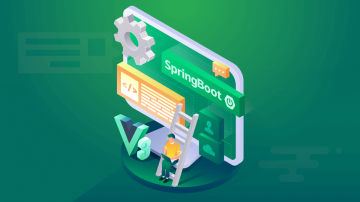本文详细介绍了SpringBoot学习的相关内容,包括SpringBoot的基本概念、主要特性和与Spring的区别。文章还涵盖了环境搭建、第一个SpringBoot项目的创建以及常用注解和项目配置的实战演练。
SpringBoot简介Spring Boot 是一个由 Spring 团队设计和开发的开源框架,其主要目的是简化新Spring应用的初始搭建以及开发过程。Spring Boot 旨在通过简化配置和依赖注入,使开发者能够更加专注于业务逻辑的实现。
什么是SpringBootSpring Boot 是 Spring 开源组织下的子项目,其主要目标是简化Spring应用的初始搭建以及开发过程,它能够快速构建独立的基于 Spring 的应用,简化了 Spring 配置的繁琐过程,减少了代码样板,使得开发更加高效。
SpringBoot的主要特性- 独立运行:基于Spring Boot的应用可以独立运行,无须部署在传统的Web服务器上,如Tomcat、Jetty等。
- 嵌入式Servlet容器:内嵌了Tomcat、Jetty或Undertow,使得应用可以直接运行,无须单独部署容器。
- 自动配置:Spring Boot会根据应用的类路径信息自动配置。
- 简化MVC:简化了Spring MVC的配置。
- 约定优于配置:根据约定,开发人员可以在最少的配置下,实现开发工作。
- 生产就绪:内嵌的Servlet容器,嵌入式数据库,自动配置等特性,使得Spring Boot的应用可以更容易地部署到生产环境中。
| 特性 | Spring | Spring Boot |
|---|---|---|
| 配置复杂度 | 需要很多XML或注解进行配置 | 一般无需XML配置,通过注解配置,自动配置 |
| 项目启动 | 需要部署到一个外部web容器(如Tomcat) | 内嵌Servlet容器,可以直接运行 |
| 依赖管理 | 不提供依赖管理,需要手动添加依赖 | 提供了自动依赖管理,可以自动添加依赖 |
| 环境配置 | 需要手动配置环境变量,数据库连接等信息 | 提供了默认配置,可以根据约定进行配置 |
| 静态资源 | 需要在web.xml中配置静态资源的映射 | 自动映射静态资源,如js、css等 |
| 配置文件 | 需要编写大量的配置文件,如applicationContext.xml | 提供了默认的application.properties或application.yml配置文件 |
环境搭建
开发工具选择
Spring Boot 支持多种开发工具,如 IntelliJ IDEA, Eclipse, 和 Spring Tool Suite (STS)。STS 是专门用于 Spring 应用开发的 IDE,提供了对 Spring Boot 的良好支持,包括自动构建、启动和调试等功能。
Maven/Gradle设置
Spring Boot 支持 Maven 和 Gradle。这里以 Maven 为例进行介绍。Maven 是一个强大的项目管理工具,可以自动管理项目的依赖,编译,打包等。
- 在
pom.xml文件中添加 Spring Boot 的依赖,如下所示:<dependencies> <dependency> <groupId>org.springframework.boot</groupId> <artifactId>spring-boot-starter-web</artifactId> <version>2.4.1</version> </dependency> </dependencies> - 在
pom.xml文件中添加 Spring Boot 的插件,如下所示:<build> <plugins> <plugin> <groupId>org.springframework.boot</groupId> <artifactId>spring-boot-maven-plugin</artifactId> </plugin> </plugins> </build>
Java环境配置
确保 Java 环境已安装并配置好。在命令行中输入 java -version,如果显示 Java 版本信息,则表明 Java 环境配置成功。
第一个SpringBoot项目
创建SpringBoot项目
- 打开 IntelliJ IDEA,选择 "File" -> "New" -> "Project"。
- 在弹出的窗口中选择 "Spring Initializr"。
- 在 "Name" 和 "Group" 选项卡中输入项目名称,如
hello-spring-boot和com.example。 - 在 "Dependencies" 选项卡中选择 "Web"。
- 点击 "Next",然后点击 "Finish" 完成项目创建。
项目结构介绍
一个典型的 Spring Boot 项目的目录结构如下:
src
├── main
│ ├── java
│ │ └── com
│ │ └── example
│ │ └── hello
│ │ ├── HelloApplication.java
│ │ └── controller
│ │ └── HelloController.java
│ └── resources
│ ├── application.properties
│ └── static
└── test
└── java
└── com
└── example
└── hello
└── HelloApplicationTests.javasrc/main/java:存放 Java 源代码。src/main/resources:存放应用的配置文件,如application.properties。src/test/java:存放测试用例。
首个Hello World程序
在 HelloApplication.java 中编写启动类,并在 HelloController.java 中编写控制器类。代码如下:
// HelloApplication.java
package com.example.hello;
import org.springframework.boot.SpringApplication;
import org.springframework.boot.autoconfigure.SpringBootApplication;
@SpringBootApplication
public class HelloApplication {
public static void main(String[] args) {
SpringApplication.run(HealthApplication.class, args);
}
}// HelloController.java
package com.example.hello.controller;
import org.springframework.web.bind.annotation.GetMapping;
import org.springframework.web.bind.annotation.RestController;
@RestController
public class HelloController {
@GetMapping("/hello")
public String hello() {
return "Hello, Spring Boot!";
}
}SpringBoot常用注解
@SpringBootApplication
@SpringBootApplication 是一个组合注解,相当于 @Configuration、@EnableAutoConfiguration 和 @ComponentScan 的集合。它可以将当前类标识为配置类,并启动自动配置和组件扫描。
@RestController
@RestController 是 @Controller 和 @ResponseBody 的组合。@Controller 用于定义控制器类,@ResponseBody 用于将返回值直接写入 HTTP 响应体中。
@Service, @Repository, @Component
@Service用于标注服务层,如业务逻辑处理。@Repository用于标注数据访问层,如持久层操作。@Component用于标注通用组件,如工具类。
@Autowired
@Autowired 用于实现依赖注入。Spring 会根据类型或名称自动将对应的 Bean 注入到标注了 @Autowired 的变量中。
项目配置
SpringBoot配置文件
Spring Boot 使用 application.properties 或 application.yml 文件来配置应用。默认的配置文件位于 src/main/resources 目录下。例如:
# application.properties
server.port=8080
spring.datasource.url=jdbc:mysql://localhost:3306/mydb
spring.datasource.username=root
spring.datasource.password=root# application.yml
server:
port: 8080
spring:
datasource:
url: jdbc:mysql://localhost:3306/mydb
username: root
password: root配置文件的常用配置项
server.port:设置应用端口。spring.datasource.url:数据库连接 URL。spring.datasource.username:数据库用户名。spring.datasource.password:数据库密码。spring.datasource.driver-class-name:数据库驱动类名。spring.jpa.hibernate.ddl-auto:设置数据库模式生成策略(如create、update、none)。spring.application.name:应用名称。spring.profiles.active:激活的配置文件。
属性注入
在 Spring Boot 中,可以通过 @Value 注解将配置文件中的属性注入到 Java 对象中。例如:
package com.example.hello;
import org.springframework.beans.factory.annotation.Value;
import org.springframework.stereotype.Component;
@Component
public class ConfigProperties {
@Value("${server.port}")
private int serverPort;
public int getServerPort() {
return serverPort;
}
}实战演练
创建一个简单的RESTful API
创建一个 RESTful API,用于返回当前时间。首先,在 controller 包下创建一个新的控制器类 TimeController。
package com.example.hello.controller;
import org.springframework.web.bind.annotation.GetMapping;
import org.springframework.web.bind.annotation.RestController;
import java.time.LocalDateTime;
@RestController
public class TimeController {
@GetMapping("/time")
public LocalDateTime currentTime() {
return LocalDateTime.now();
}
}数据库集成(JPA与MyBatis)
接下来,我们将为应用集成数据库。这里以 JPA 为例。
-
在
pom.xml文件中添加 JPA 依赖:<dependency> <groupId>org.springframework.boot</groupId> <artifactId>spring-boot-starter-data-jpa</artifactId> </dependency> -
在
application.properties文件中配置数据库连接:spring.datasource.url=jdbc:mysql://localhost:3306/mydb spring.datasource.username=root spring.datasource.password=root spring.jpa.hibernate.ddl-auto=update -
创建一个实体类
User.java:package com.example.hello.model; import javax.persistence.Entity; import javax.persistence.GeneratedValue; import javax.persistence.GenerationType; import javax.persistence.Id; @Entity public class User { @Id @GeneratedValue(strategy = GenerationType.IDENTITY) private Long id; private String name; private String email; // getters and setters } -
创建一个
UserRepository接口,继承自JpaRepository:package com.example.hello.repository; import com.example.hello.model.User; import org.springframework.data.jpa.repository.JpaRepository; public interface UserRepository extends JpaRepository<User, Long> { } -
创建一个
UserService类,用于处理与数据库相关的业务逻辑:package com.example.hello.service; import com.example.hello.model.User; import com.example.hello.repository.UserRepository; import org.springframework.beans.factory.annotation.Autowired; import org.springframework.stereotype.Service; import java.util.List; @Service public class UserService { @Autowired private UserRepository userRepository; public List<User> getAllUsers() { return userRepository.findAll(); } public User saveUser(User user) { return userRepository.save(user); } } -
创建一个
UserController类,用于处理 RESTful API 请求:package com.example.hello.controller; import com.example.hello.model.User; import com.example.hello.service.UserService; import org.springframework.beans.factory.annotation.Autowired; import org.springframework.web.bind.annotation.*; import java.util.List; @RestController @RequestMapping("/users") public class UserController { @Autowired private UserService userService; @GetMapping public List<User> getAllUsers() { return userService.getAllUsers(); } @PostMapping public User saveUser(@RequestBody User user) { return userService.saveUser(user); } }
接下来,我们将展示如何使用 MyBatis 进行数据库集成。
-
在
pom.xml文件中添加 MyBatis 依赖:<dependency> <groupId>org.springframework.boot</groupId> <artifactId>spring-boot-starter-mybatis</artifactId> </dependency> -
创建一个 MyBatis 配置文件
mybatis-config.xml,并设置application.properties中的配置:spring.datasource.url=jdbc:mysql://localhost:3306/mydb spring.datasource.username=root spring.datasource.password=root spring.mybatis.config-location=classpath:mybatis-config.xml -
创建一个 MyBatis 映射文件
UserMapper.xml:<?xml version="1.0" encoding="UTF-8" ?> <!DOCTYPE mapper PUBLIC "-//mybatis.org//DTD Mapper 3.0//EN" "http://mybatis.org/dtd/mybatis-3-mapper.dtd"> <mapper namespace="com.example.hello.mapper.UserMapper"> <select id="selectUser" resultType="com.example.hello.model.User"> SELECT * FROM users WHERE id = #{id} </select> </mapper> -
创建一个 MyBatis 映射接口
UserMapper.java:package com.example.hello.mapper; import com.example.hello.model.User; import org.apache.ibatis.annotations.Mapper; @Mapper public interface UserMapper { User selectUser(Long id); } -
创建一个 MyBatis 服务类
MybatisService.java:package com.example.hello.service; import com.example.hello.mapper.UserMapper; import com.example.hello.model.User; import org.springframework.beans.factory.annotation.Autowired; import org.springframework.stereotype.Service; @Service public class MybatisService { @Autowired private UserMapper userMapper; public User getUserById(Long id) { return userMapper.selectUser(id); } } -
创建一个控制类
MybatisController.java,用于处理 RESTful API 请求:package com.example.hello.controller; import com.example.hello.mapper.UserMapper; import com.example.hello.model.User; import com.example.hello.service.MybatisService; import org.springframework.beans.factory.annotation.Autowired; import org.springframework.web.bind.annotation.*; @RestController @RequestMapping("/mybatis") public class MybatisController { @Autowired private MybatisService mybatisService; @GetMapping("/{id}") public User getUserById(@PathVariable Long id) { return mybatisService.getUserById(id); } }
访问控制(Spring Security)
接下来,我们将为应用集成 Spring Security 进行访问控制。
-
在
pom.xml文件中添加 Spring Security 依赖:<dependency> <groupId>org.springframework.boot</groupId> <artifactId>spring-boot-starter-security</artifactId> </dependency> -
创建一个
SecurityConfig类,用于配置 Spring Security:package com.example.hello.config; import org.springframework.context.annotation.Bean; import org.springframework.context.annotation.Configuration; import org.springframework.security.config.annotation.web.builders.HttpSecurity; import org.springframework.security.config.annotation.web.configuration.EnableWebSecurity; import org.springframework.security.config.annotation.web.configuration.WebSecurityConfigurerAdapter; import org.springframework.security.web.SecurityFilterChain; @Configuration @EnableWebSecurity public class SecurityConfig { @Bean public SecurityFilterChain securityFilterChain(HttpSecurity http) throws Exception { http .authorizeRequests(authorizeRequests -> authorizeRequests .antMatchers("/", "/home").permitAll() .anyRequest().authenticated() ) .formLogin(formLogin -> formLogin .loginPage("/login") .permitAll() ) .logout(logout -> logout .permitAll() ); return http.build(); } } -
创建一个
LoginController类,用于处理登录请求:package com.example.hello.controller; import org.springframework.stereotype.Controller; import org.springframework.web.bind.annotation.GetMapping; @Controller public class LoginController { @GetMapping("/login") public String login() { return "login"; } } -
创建一个
index.html文件,位于src/main/resources/templates目录下,用于显示登录页面:<!DOCTYPE html> <html xmlns:th="http://www.thymeleaf.org"> <head> <title>Spring Boot Security Example</title> </head> <body> <h1>Welcome to Spring Boot Security Example</h1> <a th:href="@{/login}">Login</a> </body> </html> - 创建一个
login.html文件,位于src/main/resources/templates目录下,用于显示登录页面:<!DOCTYPE html> <html xmlns:th="http://www.thymeleaf.org"> <head> <title>Login Page</title> </head> <body> <h1>Login Page</h1> <form th:action="@{/login}" method="post"> <label for="username">Username:</label> <input type="text" id="username" name="username" /> <label for="password">Password:</label> <input type="password" id="password" name="password" /> <input type="submit" value="Login" /> </form> </body> </html>
通过以上步骤,我们成功地为 Spring Boot 应用集成了数据库和访问控制。

 随时随地看视频
随时随地看视频




